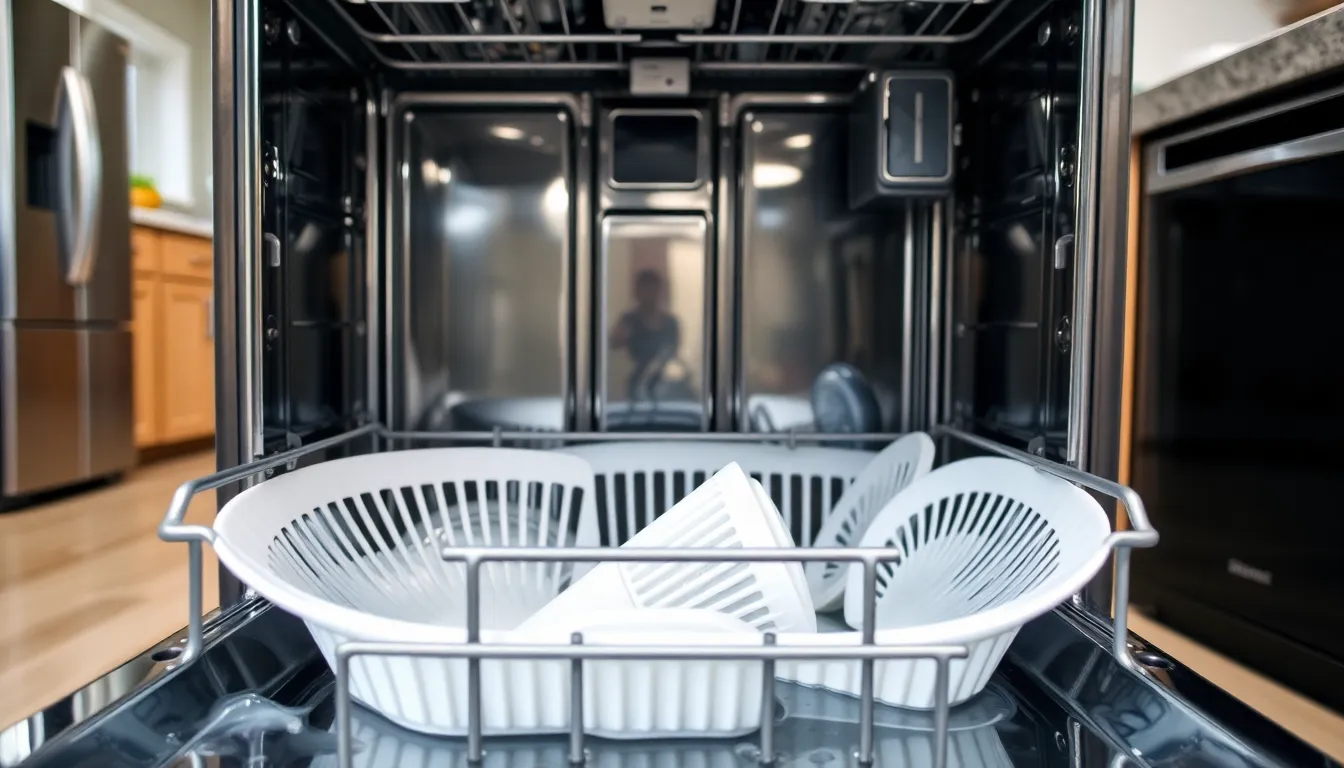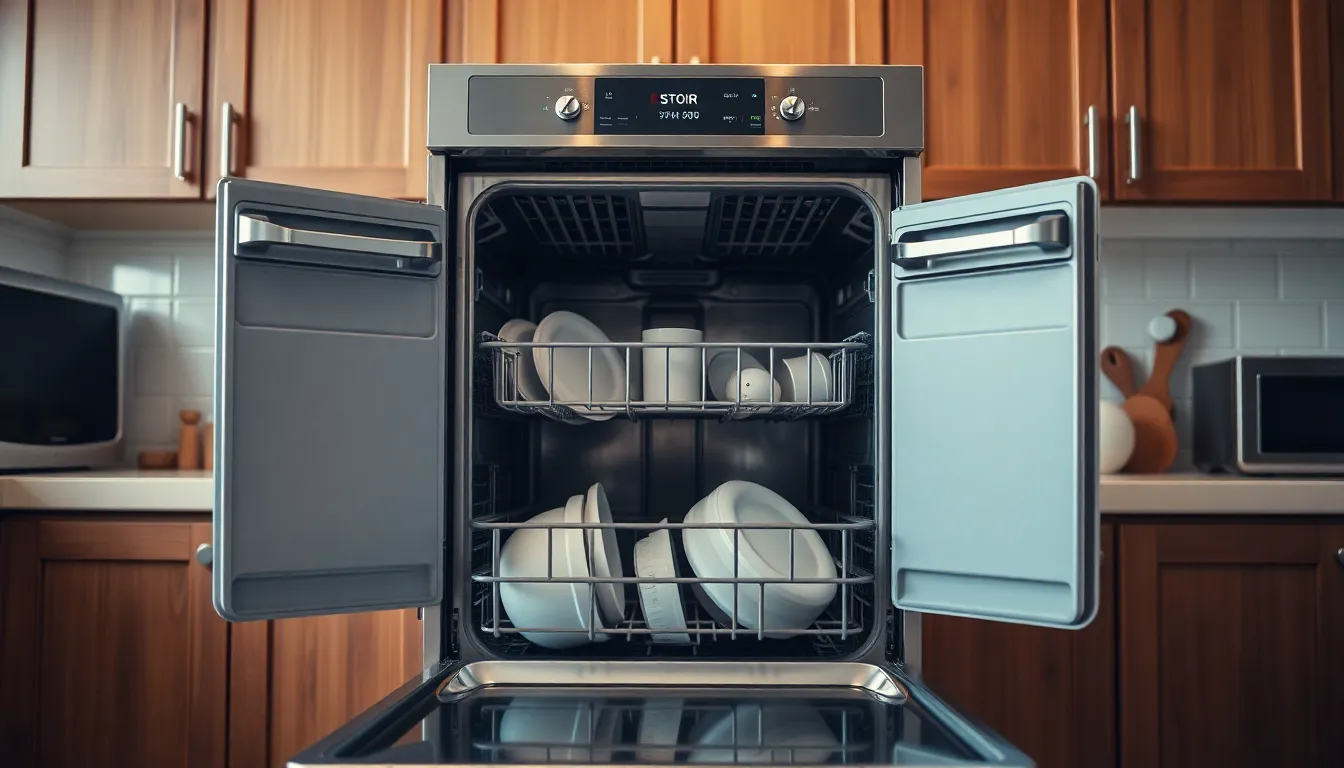A well-functioning dishwasher can be a game changer in any kitchen, saving time and effort while ensuring dishes come out sparkling clean. However, many people overlook the importance of regular upkeep, leading to decreased performance and even costly repairs. Understanding how to maintain this essential appliance is key to prolonging its lifespan and maximizing efficiency.
From routine cleaning to checking for clogs, proper dishwasher upkeep is easier than it seems. With a few simple steps, anyone can keep their dishwasher running smoothly and efficiently. This article will explore practical tips and best practices to ensure your dishwasher remains in top condition, so you can enjoy the convenience it offers without unexpected headaches.
Table of Contents
ToggleImportance of Dishwasher Upkeep
Dishwasher upkeep plays a crucial role in maintaining performance and extending lifespan. Regular maintenance prevents issues such as clogged filters, dirty spray arms, and residue buildup. Ignoring these tasks leads to reduced efficiency and potential breakdowns, which can incur expensive repairs.
Preventative care boosts performance. Clean filters ensure adequate water flow, while regular cleaning of spray arms maximizes water distribution. Proper maintenance enables dishwashers to effectively remove food particles and sanitize dishes.
Maintained dishwashers contribute to energy efficiency. A clean appliance uses less water and energy during cycles, lowering utility bills. This efficiency benefits both the environment and household budgets.
Moreover, regular upkeep promotes hygiene. Leftover food particles and grease harbor bacteria, which can contaminate clean dishes. Routine cleaning ensures a sanitary environment, maintaining the health of users.
Overall, investing time in dishwasher upkeep not only enhances performance and savings, but also ensures user satisfaction and well-being.
Common Dishwasher Issues


Dishwashers can experience various issues that diminish their performance. Recognizing and addressing these problems early maintains efficiency and prolongs the appliance’s lifespan.
Clogs and Blockages
Clogs and blockages frequently disrupt normal operation. Food particles, grease, and debris can accumulate in areas such as:
- Filters: Clogged filters reduce water flow, resulting in poor cleaning.
- Spray Arms: Blocked spray arms hinder water distribution, leaving dishes dirty.
- Drain Hoses: Obstructions in drain hoses can prevent proper drainage, leading to standing water.
Regularly inspecting and cleaning these components minimizes the risk of clogs and enhances overall efficiency.
Leaks and Water Accumulation
Leaks and water accumulation may signal significant issues. Common sources include:
- Door Seals: Worn or damaged seals can allow water to escape during cycles.
- Hoses: Cracked or loose hoses create leaks that lead to water on the floor.
- Pump Assembly: A faulty pump may cause leaks around the appliance base.
Identifying and repairing leaks promptly prevents water damage and further complications, ensuring the dishwasher functions correctly.
Routine Maintenance Tips
Routine maintenance enhances dishwasher efficiency and extends its lifespan. Regular cleaning and inspection prevent common issues and ensure optimal performance.
Cleaning the Filter
Cleaning the dishwasher filter maintains proper functionality. He or she should remove the filter every month and rinse it under warm water to eliminate food particles and debris. Checking the manufacturer’s instructions enables correct handling and prevents damage. A clean filter promotes effective drainage and minimizes clogs, ensuring smooth operation.
Checking and Cleaning Spray Arms
Checking and cleaning spray arms ensures effective water distribution. Users must inspect the spray arms monthly for clogs caused by food residue or mineral buildup. To clean, remove the spray arms and soak them in warm, soapy water. Use a small brush to scrub any obstructions before rinsing thoroughly. Replacing spray arms in proper alignment guarantees adequate washing coverage, enhancing cleaning performance and preventing stagnation or uneven washes.
Deep Cleaning Your Dishwasher
Deep cleaning a dishwasher elevates its performance and maintains hygiene. Regular thorough cleaning prevents buildup of grime and odors, ensuring efficient operation.
Using Vinegar and Baking Soda
Using vinegar and baking soda serves as an effective natural cleaning method. He or she should start by removing the bottom rack and checking for debris. Next, they should place a cup of vinegar in a dishwasher-safe container on the top rack. Running a hot water cycle will help dissolve grease and remove odors. After that, they can sprinkle a cup of baking soda on the bottom and run a short hot cycle. This process targets stains and leaves the interior fresh. Both vinegar and baking soda are safe cleaning agents, making them ideal for routine maintenance.
Professional Cleaning Services
Professional cleaning services offer an in-depth solution for maintaining dishwasher efficiency. These services typically include comprehensive cleaning of internal components, such as the filter, spray arms, and drain. Technicians possess the expertise and specialized tools necessary for removing stubborn buildup that may be overlooked during routine upkeep. Users should schedule professional cleanings every 1-2 years for optimal results, ensuring the appliance functions at peak performance and extends its lifespan. Investing in expert maintenance can prevent future costly repairs and bolster dishwasher efficiency.
Signs Your Dishwasher Needs Repair
Recognizing signs that indicate a dishwasher requires repair is crucial for maintaining efficiency and performance. Identifying these issues early can prevent costly repairs.
Common Indicators
- Water Leakage: Persistent leaks around the dishwasher can signify a faulty door seal, a worn-out hose, or issues with the pump assembly. Inspecting for water pooling under or near the appliance serves as a reliable diagnostic method.
- Incomplete Cleaning: If dishes come out dirty or have food residue, check for clogged spray arms or a malfunctioning filter. Ensuring a proper spray pattern allows for effective cleaning.
- Unusual Noises: Loud, grinding, or rattling sounds during operation typically indicate loose parts or issues with the motor. Identifying these unusual noises can help address problems early.
- Odors: Foul smells emanating from the dishwasher often point to food particles trapped in the filter or drain. Regular cleaning prevents odor buildup and ensures a hygienic environment.
- Error Codes: Modern dishwashers display error codes when malfunctions occur. Referencing the user manual for the specific appliance can provide clarity on these codes, indicating required repairs.
Performance Issues
- Water Not Heating: If the water fails to heat properly, it can impact cleaning performance. There might be an issue with the heating element or thermostat if dishes are not drying efficiently.
- Draining Problems: Slow or incomplete drainage may result from clogs in the filter or drain hose. Analyzing drainage performance is necessary for maintaining dishwasher efficiency.
- Delayed Cycle Completion: If wash cycles take significantly longer than expected, there may be underlying issues with the control board or malfunctioning sensors. Monitoring the cycle duration can reveal patterns requiring attention.
Identifying these signs promptly ensures timely repairs, enhancing the dishwasher’s longevity and operational efficiency.










